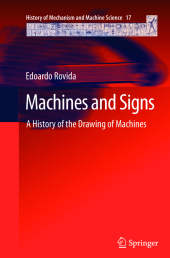 Neuerscheinungen 2015Stand: 2020-02-01 |
Schnellsuche
ISBN/Stichwort/Autor
|
Herderstraße 10
10625 Berlin
Tel.: 030 315 714 16
Fax 030 315 714 14
info@buchspektrum.de |

Edoardo Rovida
Rovida:Machines and Signs
A History of the Drawing of Machines
2013. 2015. x, 250 S. 235 mm
Verlag/Jahr: SPRINGER NETHERLANDS; SPRINGER 2015
ISBN: 9400796986 (9400796986)
Neue ISBN: 978-9400796980 (9789400796980)
Preis und Lieferzeit: Bitte klicken
This book explores cultural, technical and ethical aspects of drawing of machines, from the Renaissance through 18th century orthographic projections, the 19th century and drawing in industry and the 20th century advent of standardization and computers.
This volume addresses the cultural, technical and ethical motivations of the history of drawing of machines and its developments step by step. First it treats drawings without any technical character; then the Renaissance with its new forms of drawing; the 18th century, with orthographic projections, immediately used by industry; the 19th century, including the applications of drawing in industry; and the 20th century, with the standardization institutions and the use of the computer. The role of historical drawings and archives in modern design is also examined.
This book is of value to all those who are interested in technical drawing, either from an artistic, from a design, or from an engineering point of view.
1. Introduction: State of the art.- Some preliminary considerations about the history of drawing.- Conclusions.- 2. Motivation of the history of technique: Culture.- Technique.- Aesthetics.- Ethic.- 3. The first steps: Introduction.- Prehistoric Age.- Ancient times.- Middle Ages.- Conclusions.- 4. Renaissance: General considerations.- The authors.- Introduction.- Examples.- The first steps of the scientific documentation.- The first "technical" drawings.- Some conclusions.- 5. The 18th Century: Introduction.- Gaspard Monge.- The orthographic projections.- The first application of orthographic projections.- The encyclopedic books.- The drawing as didactic and popular tool.- The drawing as documentary tool for scientists.- The drawing instruments.- 6. The 19th Century: Introduction.- The first modern industries.- First steps of the institutionalized teaching.- The drawing as documentation tool for scientists.- The drawing as tool for scientific-technical divulgation.- Drawing instruments.- 7. The 20th Century: Introduction.- Drawing standards.- Historical background.- Standardization Institutions.- Drawing standards.- Development of industry.- Industries born in 20th Century.- Examples of drawings of 19th Century.- Development of technical schools.- General characters.- Fundamental steps.- Since 1900 to 1920.- Since 1920 to 1950.- Since 1950 to 1970.- Since 1970 until today.- Application of the computer.- Drawing instruments.- 8. Archives of historical drawings: Role of archives of historical drawings.- Steps to realize an historical archive.- Examples applied to the car suspensions.- General considerations.- Structure of the data base.- 9. The critical observation of historical drawings: Technicians, engineers and designers.- Standardization organizations.- Teachers and students.- Historians.- The lesson of historical heritage.- Index.
From the reviews:
"This volume has a primarily historic format, tracing the development of drawing, illustration, and diagrams from antiquity to the present. ... Each chapter carefully notes the cultural context in which the technology, engineering, and science of the time were embedded. ... This superbly illustrated and historically important work will be a valuable addition to history of science, engineering, or drawing/design collections. Summing Up: Highly recommended. Upper-division undergraduates and above." (R. M. Davis, Choice, Vol. 51 (2), October, 2013)


